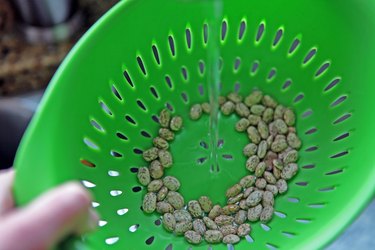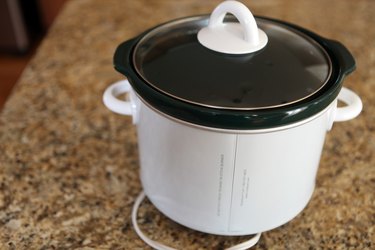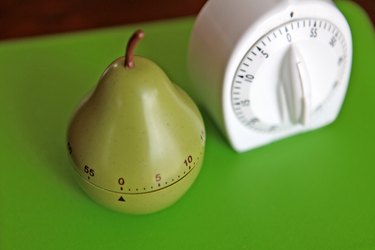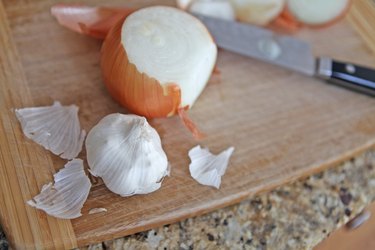
Beans are a non-meat protein that is low in fat and high in fiber. You'd think by now someone would have resolved that one little thing that's not so lovable: the embarrassing gas they cause.
High fiber and complex sugars called oligosaccharides are to blame for this problem. Enzymes that encounter these sugars in the digestive tract work overtime to make sure they get digested and, as a result, gas is the side effect, according to the American Chemical Society.
Video of the Day
Video of the Day
Incorporating a special hot soak, a presoaking method to help break down the complex sugars in dry pinto beans, can help prevent gas.
Here's how to cook pinto beans so that they're relatively gas-free.
Things You'll Need
Pinto beans
Large colander
Large covered saucepan or slow cooker
Spices, herbs and other ingredients
Step 1: Add Beans to Colander

Pour or scoop pinto beans into a large colander. Carefully pick through the beans, removing small stones, sticks, broken beans and any other impurities.
Step 2: Rinse Beans

Rinse and clean the beans while they are still in the colander by using cold running water. Stir or swish the beans constantly, so they all get washed.
Step 3: Add Water

Place the beans in the pan, pot or slow cooker. Add 10 cups of hot water for each pound of pinto beans. Beans will hydrate two or more times their dry size, so use a pot that is large enough to accommodate them.
Ideally, your cooking vessel should never be more than half full.
Step 4: Soak Beans

Slowly bring the beans and hot liquid to a simmering boil and let them boil for 2 or 3 minutes. Remove the pot from heat (or turn off the slow cooker) and cover the container, allowing the beans to soak for at least 1 hour, but ideally for 4 hours.
During this hot soak, you are drawing out indigestible, gas-causing carbohydrates.
Step 5: Cook Beans

Discard the soak water by pouring it down the sink. Cover the beans with fresh water and bring them to a boil. Reduce heat to a simmer and cook until beans are tender but not mushy, which usually takes 2 to 3 hours on your stovetop and 4 to 6 hours in a slow cooker.
Prevent bean skins from bursting by simmering gently and stirring very little.
Tip
Don’t add salt, spices or other ingredients until after the cooking phase, because they will go down the drain when all soaking and cooking liquids are discarded. Acidic ingredients, such as tomatoes, lemon juice, wine and vinegar, delay bean softening so they should be added after cooking.
Step 6: Add Flavor

Drain and discard all cooking water when beans are fully cooked and follow your recipe, adding either water or vegetable or chicken broth, spices, herbs and other ingredients. For plain pinto beans, add a sprinkle of sugar and chopped garlic to greatly enhance flavor, per New Mexico State University.
Heat beans to serving temperature.
Tips for Gas-Free Pinto Beans
- Discard all soaking and cooking water — even if you soak beans two or three times — because the indigestible carbs drawn from the beans during soaking are in the water. Important nutrients will not be lost.
- You can speed up the cooking time for pinto and other beans by using a pressure cooker.
- If you're cooking beans for a crowd, note that each pound of dry pinto beans makes 12 half-cup servings after being cooked, so you'll need 8.33 pounds to make 100 servings.
- When adding fiber to your diet, which is a great idea for gut health, do so gradually. Make one dietary change at a time to give your system time to adjust. This will seriously reduce the amount of indigestion and gas you get.
Related Reading